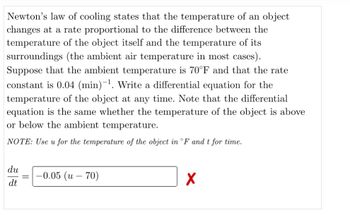Newton's law of cooling states that the temperature of an object changes at a rate proportional to the difference between the temperature of the object itself and the temperature of its surroundings (the ambient air temperature in most cases). Suppose that the ambient temperature is 70°F and that the rate constant is 0.04 (min) ¹. Write a differential equation for the temperature of the object at any time. Note that the differential equation is the same whether the temperature of the object is above or below the ambient temperature. NOTE: Use u for the temperature of the object in °F and t for time. du dt ||
Newton's law of cooling states that the temperature of an object changes at a rate proportional to the difference between the temperature of the object itself and the temperature of its surroundings (the ambient air temperature in most cases). Suppose that the ambient temperature is 70°F and that the rate constant is 0.04 (min) ¹. Write a differential equation for the temperature of the object at any time. Note that the differential equation is the same whether the temperature of the object is above or below the ambient temperature. NOTE: Use u for the temperature of the object in °F and t for time. du dt ||
Advanced Engineering Mathematics
10th Edition
ISBN:9780470458365
Author:Erwin Kreyszig
Publisher:Erwin Kreyszig
Chapter2: Second-order Linear Odes
Section: Chapter Questions
Problem 1RQ
Related questions
Question
6.Please circle the answer ty!

Transcribed Image Text:Newton's law of cooling states that the temperature of an object
changes at a rate proportional to the difference between the
temperature of the object itself and the temperature of its
surroundings (the ambient air temperature in most cases).
Suppose that the ambient temperature is 70°F and that the rate
constant is 0.04 (min) ¹. Write a differential equation for the
temperature of the object at any time. Note that the differential
equation is the same whether the temperature of the object is above
or below the ambient temperature.
NOTE: Use u for the temperature of the object in °F and t for time.
du
dt
||
Expert Solution
This question has been solved!
Explore an expertly crafted, step-by-step solution for a thorough understanding of key concepts.
Step by step
Solved in 2 steps with 2 images

Follow-up Questions
Read through expert solutions to related follow-up questions below.
Follow-up Question

Transcribed Image Text:Newton's law of cooling states that the temperature of an object
changes at a rate proportional to the difference between the
temperature of the object itself and the temperature of its
surroundings (the ambient air temperature in most cases).
Suppose that the ambient temperature is 70°F and that the rate
constant is 0.04 (min)-¹. Write a differential equation for the
temperature of the object at any time. Note that the differential
equation is the same whether the temperature of the object is above
or below the ambient temperature.
NOTE: Use u for the temperature of the object in °F and t for time.
du
dt
-0.05 (u - 70)
X
Solution
Recommended textbooks for you

Advanced Engineering Mathematics
Advanced Math
ISBN:
9780470458365
Author:
Erwin Kreyszig
Publisher:
Wiley, John & Sons, Incorporated

Numerical Methods for Engineers
Advanced Math
ISBN:
9780073397924
Author:
Steven C. Chapra Dr., Raymond P. Canale
Publisher:
McGraw-Hill Education

Introductory Mathematics for Engineering Applicat…
Advanced Math
ISBN:
9781118141809
Author:
Nathan Klingbeil
Publisher:
WILEY

Advanced Engineering Mathematics
Advanced Math
ISBN:
9780470458365
Author:
Erwin Kreyszig
Publisher:
Wiley, John & Sons, Incorporated

Numerical Methods for Engineers
Advanced Math
ISBN:
9780073397924
Author:
Steven C. Chapra Dr., Raymond P. Canale
Publisher:
McGraw-Hill Education

Introductory Mathematics for Engineering Applicat…
Advanced Math
ISBN:
9781118141809
Author:
Nathan Klingbeil
Publisher:
WILEY

Mathematics For Machine Technology
Advanced Math
ISBN:
9781337798310
Author:
Peterson, John.
Publisher:
Cengage Learning,

